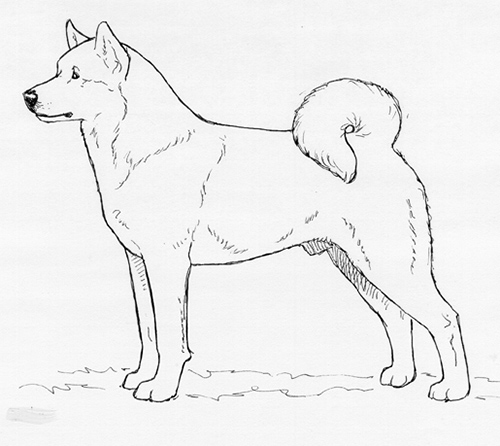Kishu
Northern Breed Group
The goals and purposes of this breed standard include: to furnish guidelines for breeders who wish to maintain the quality of their breed and to improve it; to advance this breed to a state of similarity throughout the world; and to act as a guide for judges.
Breeders and judges have the responsibility to avoid any conditions or exaggerations that are detrimental to the health, welfare, essence and soundness of this breed, and must take the responsibility to see that these are not perpetuated.
Any departure from the following should be considered a fault, and the seriousness with which the fault should be regarded should be in exact proportion to its degree and its effect upon the health and welfare of the dog and on the dog’s ability to perform its traditional work.
History
The Kishu is descended from the medium sized dogs that existed in Japan in ancient times. It became established as an individual breed in the mountainous regions of Kishu, and takes its name from the region in which it was developed. Originally, the breed was found in varying colorations, but after 1934 only solid colors were accepted. The Kishu is a hunting dog, used mainly on wild boar.
The Kishu was recognized by the United Kennel Club in 2006.
General Appearance
The Kishu is a medium sized, well-balanced, compact and muscular breed with prick ears and a curled or sickle tail. The breed gives the appearance of being capable of great endurance. Males are distinctly masculine and females feminine.
Faults: Lack of secondary sex characteristics.
Characteristics
A noble and dignified breed, the Kishu is faithful, docile and alert.
Head
SKULL
The forehead is broad. There is an abrupt stop, with a slight furrow. The cheeks are relatively well developed.
MUZZLE
The muzzle is wedge shaped, fairly thick, tapering but not pointed. The nasal bridge is straight and the lips are tight.
TEETH
The Kishu has a complete set of evenly spaced, white teeth meeting in a scissors bite.
Disqualifications: Extremely overshot or undershot bite.
NOSE
Generally black, but flesh colored is accepted in white dogs.
EYES
Fairly small and nearly triangular in shape, the eyes are set well apart and are dark in color.
EARS
Small, triangular in shape, firmly pricked, and inclined slightly forward.
Disqualification: Ears not pricked.
Neck
Thick and muscular.
Forequarters
The shoulders are moderately sloping and well muscled. Angulation between the shoulder blade and upper arm is moderate.
FORELEGS
The forelegs are straight, with the elbows held close to the body, and the pasterns slightly inclined. Bone is strong.
Body
In proportion, the Kishu is slightly longer than tall, measured from the breastbone to the point of buttocks and the withers to the ground. The chest is deep, and the ribs are moderately sprung. The withers are high, and the back is short and straight. The loin is broad and muscular, and the belly is well tucked up.
Hindquarters
The upper thighs are long, and the lower thighs are short. The hocks are tough and strong.
Feet
The toes are close and well arched. The pads are thick and elastic. The nails are hard, and preferably dark in color.
Tail
The tail is thick, set on high, and carried curled or curved like a sickle over the back. Pulled down, the tail is nearly long enough to reach to the hock joint.
Disqualifications: Short or hanging tail.
Coat
Double, with a harsh, straight outer coat and a soft, dense undercoat. The hair on the cheeks and the tail is fairly long.
Fault: Distinctly long coat.
Color
Red, white and sesame (red hairs with black tips).
Height
Height at the withers for males is 20.5 inches. For females, it is 18 inches. There is a tolerance of one inch in either direction in both sexes.
Gait
Light and resilient.
Disqualifications
(A dog with a Disqualification must not be considered for placement in a conformation event, and must be reported to UKC.)
Unilateral or bilateral cryptorchid.
Viciousness or extreme shyness.
Albinism.
Extremely overshot or undershot bite.
Ears not pricked.
Short or hanging tail.

Looking for a Dog?
Find a dog that will fit your family.
Note: The breeders on this list are not endorsed by UKC.
©Copyright 2006, United Kennel Club
